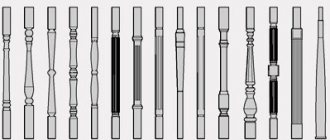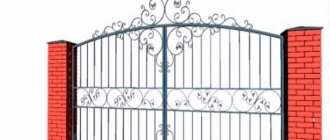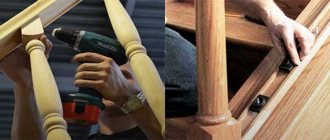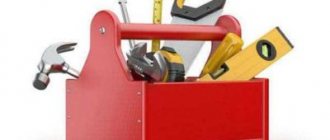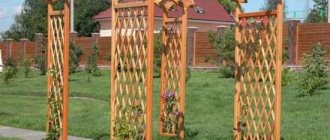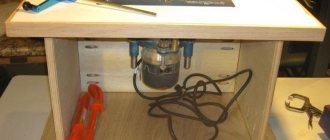Beautiful and reliable wooden balusters can be purchased complete with the staircase structure. Experienced carpenters advise trying to make such parts with your own hands.
Work on turning or milling shapes will require a lathe or milling woodworking machine, a set of hand tools and experience in performing such operations.
Methods for making wooden balusters
According to the manufacturing method, wooden decorations for stairs and railings are divided into 3 main groups.
| Classification | Short description |
| Turned on a lathe | They are made of round shape from wood with various decorations. Not the most difficult option, but it requires the ability to work with cutters of various shapes. |
| Milled | Depending on the sketch, round or rectangular shapes of staircase elements are made. On such balusters you can create a unique design using longitudinal and transverse screw threads or decorate them with other patterns. |
| Balusters with elements of manual or mechanical wood carving | For the production of industrial parts, computer-controlled machines are used. A home handyman will need experience in performing such work and a lot of time. Therefore, stairs or railings with such elements are quite rare. |
The main purpose of balusters and support posts is to create a rigid and safe staircase structure. Additionally, they can serve as decorative elements, but such work requires skill and experience in woodworking.
Functional purpose and positive characteristics
Durable wooden deck balusters perform several important functions. That is why these products must be as durable and reliable as possible.
Main functions of racks:
- used as a support;
- provide the necessary stability to the ladder;
- give the stairs an aesthetically attractive appearance;
- provide the necessary safety for human movement from the first floor to the second.
Balusters made from durable solid wood are very popular among private property owners. High-quality products have the following advantages:
- Wood goes well with all modern finishing materials and interiors.
- Long service life and maximum strength. High-quality racks can last for decades. The minimum service life of solid wood structures is 45 years.
- Environmentally friendly. The material is absolutely safe for the environment and human health, as it does not emit toxic substances into the air. Natural resins have a powerful healing effect.
- Aesthetic appeal. Manufactured stairs can boast of their sophistication and originality. In combination with properly selected decorative finishing, the interior of the room becomes extraordinary and luxurious.
- You can make original racks yourself.
- Huge selection of natural raw materials. Wood is ideal for realizing the most unexpected design ideas.
- Damaged staircase elements can be restored or replaced.
A universal model with an unusual pattern
Variety of shapes
A beautiful baluster, regardless of whether it is wooden or plastic, will decorate the stairs in the house. The design of the decorative stand is conventionally divided into several parts:
- the lower part, which is attached to the step or floor covering - the base;
- the central segment with decorations and carvings is the body;
- The upper support is designed to connect to the railing and increase the area of the joint.
Important! When making or purchasing ready-made decorative parts, you need to decide on their length. The size depends on the height of the staircase railing, but the balusters should have a small margin in length to make corner cuts when joining with the overall structure.
According to their shape, wooden products are divided into cylindrical, ellipsoidal, rectangular and figured.
A cylindrical baluster made of wood is a classic type of product on which various decoration and decorative elements are made. The pattern consists of various differences in thickness. Such parts can only be made with special cutters on a lathe.
Elliptical or rectangular balusters are made according to a sketch using a jigsaw. Various designs are made on the body using a manual milling cutter or CNC machines.
Figured stands with elements of hand-carved wood are made from expensive types of wood (hard fruit or exotic).
Is it possible to do it yourself?
It is possible to make wooden decorations for the stairs with your own hands, but this will require knowledge and experience in working with a woodworking machine, as well as a full set of cutters. Simple wooden posts with slightly rounded corners don't require much expertise but won't add any appeal to a staircase or railing. They are suitable for a country house or temporary building.
A staircase with cylindrical turned lintels will look more attractive, but making the balusters identical on a simple lathe is a difficult task that only experienced carpenters can do. If you have a supply of bars, time and desire, then any craftsman who knows how to handle wood can handle the job.
Advice! You can cut a flat type of baluster from a board according to a template, process the edges with a hand router, sand and stain the parts with stain.
Flat, simple parts are easier to attach to the overall staircase structure, but during manufacturing it is important to take into account the width of the steps.
Dimensions and prices for blanks for balusters and initial posts
| Size (mm) | Price | |||||||
| Oak cat. "A" | Oak cat. "E" | Ash cat. "A" | Ash cat. "E" | Larch cat. "A" | Larch cat. "E" | Beech cat. "A" | Beech cat. "E" | |
| 50x50x900 | 500 rub. | — | — | — | 350 rub. | 280 rub. | — | 410 rub. |
| 60x60x900 | 660 rub. | — | — | — | — | — | — | — |
| 80x80x1200 | 1850 rub. | — | 1260 rub. | — | 900 rub. | 950 rub. | — | — |
| 100x100x1200 | 2500 rub. | — | 1860 rub. | — | 1300 rub. | 1350 rub. | — | — |
| 120x120x1200 | 3000 rub. | — | — | — | — | — | — | — |
Mounting methods
Regardless of the design, balusters for stairs are secured in three main ways.
On a tenon or dowel
This method will allow you to quickly install the staircase structure. Furniture and other wooden structures are assembled using cylindrical dowels. For better fixation, wooden parts are additionally glued with PVA wood glue or other compounds. Holes are drilled on the staircase structure and at the end of the balusters and connected using wooden cylinders.
The disadvantage of this method is that the connection is permanent, and if it breaks, you will have to drill out the remaining dowels and repeat the assembly. To fix a fault in the structure, you will need to completely remove the railing and make repairs, so this type of connection is rarely used.
On a stiletto heel
It is possible to attach balusters to a stud in structures of any complexity. This is one of the most popular ways to assemble a stair railing. A hole along the length is drilled in the baluster into which a mounting pin is inserted. When working, mark the fastening points on the steps or deck boards, and drill larger holes for free passage of the studs.
A groove is drilled on the side of the end part of the step in the center of the hole to install the fastening nut. Before assembly, for better fixation, a layer of glue is applied to the parts, tightly connected along the marking contour and the thread of the metal rod is tightened. It is more difficult to secure the fence to the railing. To do this, it is recommended to use special screw-in hinges. With the help of such a device, the structure is easily and quickly connected; just press the handrail tightly and secure it with a nut.
Self-tapping screws
The most universal method of installing staircase structures and railings to steps and strings is using self-tapping screws. In this case, several assembly options are used:
- with fastening through balusters;
- using a base plate;
- using direct fixation of parts and assemblies.
Each method involves fastening wooden balusters through steel plates that securely hold the segment. This is due to the use of 4 support points (screws). With the help of a decorative detail of the baluster it is possible to hide the attachment point.
On a staircase that is not equipped with risers, the parts are fastened together on the underside without disturbing the overall appearance of the structure. To secure the racks to the bowstring, rotating elements are used, which allow you to fix the balusters to the side of the stringer. Using this technique, it is possible to expand the usable area of the steps by placing the structure at the end of the staircase or fence.
Advice! When trimming and adjusting balusters, it is important to prevent chips and cracks on decorative parts. To do this, you will need to wrap the ends with tape or tape. After this, when trimming with a hacksaw or jigsaw, the likelihood of chipping is reduced to zero.
Recommendations for installing balusters
Before starting work, the master needs to remember the simple rules for installing the staircase structure:
- maximum distance between balusters 150 mm;
- For any assembly methods, be sure to use a layer of wood glue - this will protect against unpleasant squeaking when loosening threaded connections and will increase the reliability of the connection;
- maximum railing height 900 mm;
- installation begins with the installation and fastening of the outer support pillars of the span;
- At the ends of the balusters, holes are pre-drilled, the diameter of which is 2–3 mm smaller than that of self-tapping screws and studs.
You can make balusters yourself, but you need skill in working with woodworking machines and performing painting work on wood. Simple flat stands can be made by any home craftsman who knows how to work with a jigsaw and a grinding machine. We recommend that you first practice and make a simple fence on a terrace or in a garden gazebo, and then start building a complex staircase structure.
Prices and sizes of initial “Box” posts
| Type | Size (mm) | Price |
| №1 | Initial column “Box” (not hollow) No. 1, larch, 135x135x1150 | 5000 rub. |
| Initial column “Box” (not hollow) No. 1, oak, 140x140x1250 | 7500 rub. | |
| №2 | Initial column “Box” (not hollow) No. 2, larch, 135x135x1150 | 5000 rub. |
| Initial column “Box” (not hollow) No. 2, oak, 140x140x1250 | 7500 rub. | |
| Initial post “Box” (not hollow) No. 2, pine, 135x135x1150 | 4000 rub. | |
| №3 | Initial column “Box” (not hollow) No. 3, oak, 140x140x1250 | 7500 rub. |
| Initial column “Box” (not hollow) No. 3, oak, 160x160x1250 | 8500 rub. | |
| №3 | Initial column “Box” (not hollow) No. 3, larch, 135x135x1150 | 5000 rub. |
| Initial column “Box” (not hollow) No. 3, larch, 155x155x1250 | 7700 rub. | |
| №3 | Initial post “Box” (not hollow) No. 3, pine, 135x135x1150 | 4000 rub. |
| Initial post “Box” (not hollow) No. 3, pine, 155x155x1250 | 5000 rub. | |
| №4 | Initial column “Box” (not hollow) No. 4, larch, 135x135x1150 | 5000 rub. |
| Initial column “Box” (not hollow) No. 4, oak, 140x140x1250 | 7500 rub. | |
| Initial post “Box” (not hollow) No. 4, pine, 135x135x1150 | 4000 rub. | |
| Platform for the starting post | To order , Pine, On a pole: 80x80; 100x100; 120x120; 150x150; 200x200; etc. Thickness: 18; 28; 40. | from 200 rub. |
| To order , Larch, On a pole: 80x80; 100x100; 120x120; 150x150; 200x200; etc. Thickness: 18; 28; 40 | from 350 rub. | |
| To order , Oak, On a pole: 80x80; 100x100; 120x120; 150x150; 200x200; etc. Thickness: 20; thirty; 40. | from 500 rub. |
